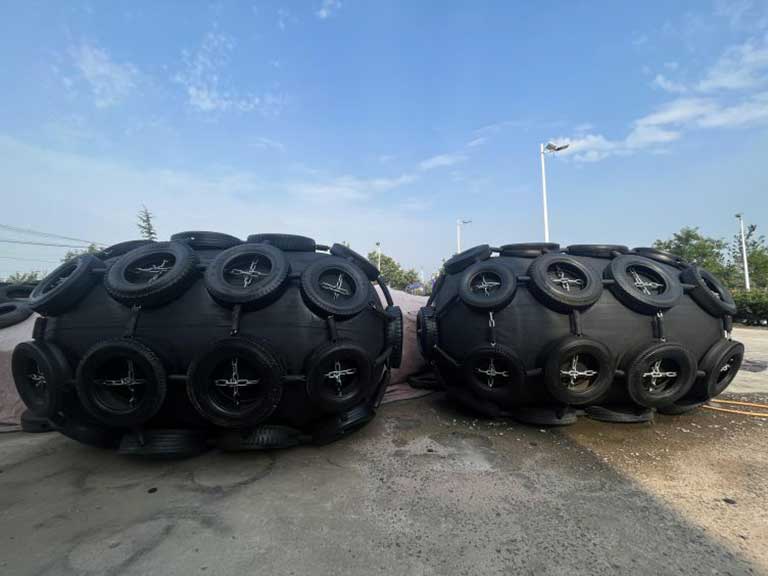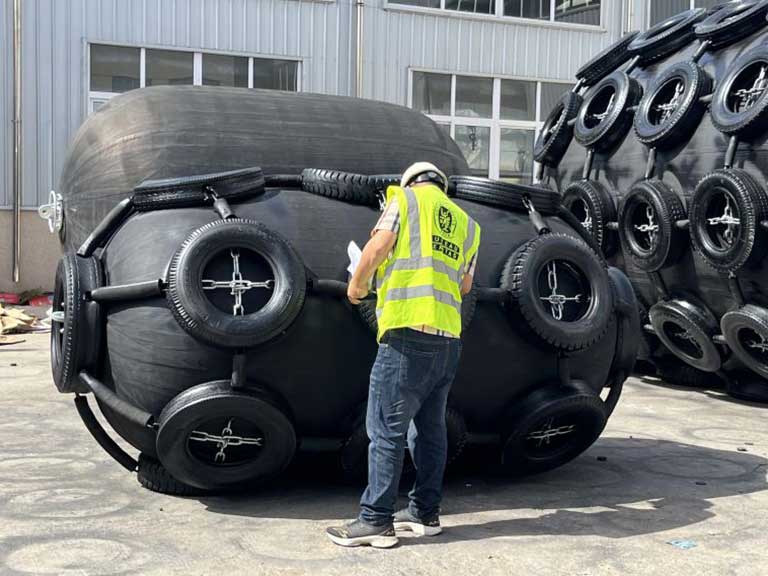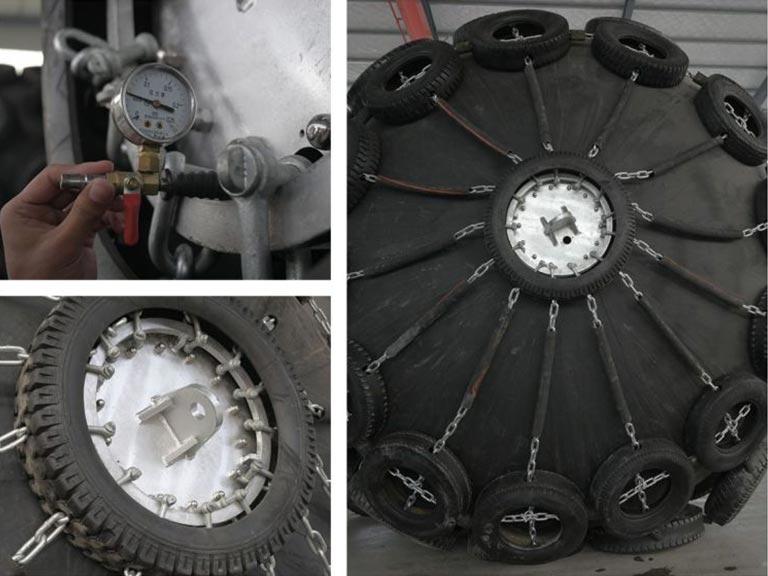Proper inflation of pneumatic fenders is critical. If pneumatic fenders are underinflated, they cannot effectively cushion collisions. This increases the risk of damage to ships and docks. On the other hand, if pneumatic fenders are overinflated, they may deform or even be damaged. This also reduces their effective protective capabilities.
Therefore, properly inflating pneumatic rubber fender not only helps protect assets but also extends the lifespan of the fenders. This ensures the long-term safe operation of ships and docks. In this article, we will provide a detailed explanation of the steps and precautions for properly inflating pneumatic fenders.
Table of Contents
What Are Pneumatic Fenders?
Pneumatic fenders, also known as Yokohama fenders. This is a specialized inflatable marine equipment. Its function is to absorb impact forces and prevent damage during ship berthing and ship-to-ship operations.
Pneumatic fenders typically consist of a reinforced rubber body and an internal air chamber. When properly inflated, they provide excellent energy absorption capabilities. Therefore, how to properly inflate pneumatic fenders
Why Proper Inflation Matters: Proper inflation directly affects a fender’s performance. Maintaining the correct pressure ensures optimal energy absorption and distribution during impact. When the pneumatic fender is fully inflated, it achieves a perfect balance between strength and flexibility. This allows it to effectively protect the ship without causing damage to the fender or the ship.
Risks of Improper Inflation: Underinflated fenders cannot effectively absorb impact forces. This may result in damage to the vessel. Overinflation, on the other hand, causes the fender to become too rigid, reducing its shock-absorbing capabilities. This may result in the fender bursting under pressure or damaging the vessel’s surface. Additionally, different types of inflatable fenders require specific inflation pressures based on their size, structure, and intended use.

Essential Equipment for Inflating Pneumatic Fenders
Pneumatic fender inflation demands specific equipment for optimal performance. We emphasize the importance of selecting the right tools to achieve the correct pressure levels and ensure safe, efficient operation.
Types of Air Sources
Various air sources can be used to inflate pneumatic fenders. These include hand pumps, foot-operated pumps, portable air compressors, and service station air pumps. Each type offers different advantages depending on the fender size and location.
For example, manual pumps and foot pumps are suitable for smaller fenders or for use in situations where there is no power supply. However, using them requires more physical effort and time. On the other hand, air compressors inflate faster and provide more stable pressure. This makes them ideal for inflating larger fenders or multiple fenders.
Inflation Adapters and Nozzles
A dedicated inflation adapter is essential for establishing a secure connection between the air source and the fender valve. This prevents air leaks during inflation. In addition, the correct nozzle type ensures that the appropriate airflow enters the valve system. This prevents damage to the internal components of the pneumatic fender.
Pressure Gauges and Measurement Tools
Pressure gauges are essential for monitoring internal air pressure accurately, helping prevent over-inflation. Digital pressure gauges offer more precise readings than analog versions, though both are effective when properly calibrated.
On the other hand, when using a gas station air pump, be sure to install a pressure gauge. This will prevent accidental overinflation, which can damage the fender valve or cause catastrophic failure.

Step-by-Step Guide to Inflate Pneumatic Fenders
To get the most out of your pneumatic fenders, follow our step-by-step inflation guide. Inflating your fender correctly is crucial for its performance and longevity.
Preparation Steps
Before you start inflating the pneumatic fender, make sure you have all the necessary equipment ready. This includes a gas source, suitable adapters, a pressure gauge, and any tools provided by the manufacturer. Inspect the fender for any damage, paying special attention to the valve area and seams.
- Gather necessary equipment: air source, adapters, pressure gauge.
- Inspect the fender for damage, especially around the valve and seams.
- Position the fender in a stable location where it can expand freely.
Accessing the Valve
To access the valve, remove any protective caps or covers, being careful not to damage the valve threads. Most pneumatic fenders have a check valve or backflow prevention mechanism that must be properly engaged during inflation.
- Remove protective caps or covers from the valve.
- Ensure the check valve or backflow prevention mechanism is properly engaged.
Proper Inflation Technique
Connect your air source to the fender using the appropriate adapter, ensuring a secure fit. Inflate the fender gradually, checking the pressure regularly to avoid exceeding the manufacturer’s recommended levels. The fender should be firm but still allow about 1/4 inch depression when pressed with your thumb.
| Inflation Method | Pressure Check | Fender Firmness |
| Gradual inflation with air source | Regular checks with a pressure gauge | Firm but yielding to thumb pressure |
| Using a gas station or a portable air compressor | Set gauge at 2 PSI | Measure circumference against the manufacturer’s chart |
Securing the Valve After Inflation
Once the desired pressure is achieved, quickly disconnect the air source and secure the valve to prevent air loss. Tighten the valve cap until it’s flush with the valve housing, but avoid overtightening.
- Disconnect the air source.
- Secure the valve cap.
- Perform a final inspection for any signs of damage or air leaks.

Determining the Correct Pressure for Different Fender Types
Inflating pneumatic fenders to the correct pressure is critical to their performance. The pressure depends on the type, size, and application of the fender. Different types and sizes of inflatable fenders require specific pressure settings. This allows the fenders to perform optimally in a variety of marine applications.
Standard Pressure Guidelines: Most commercial pneumatic fenders have standard pressure guidelines ranging between 50-80 kPa (approximately 7-11.6 PSI) at 0% deflection. However, this can vary by manufacturer and model.
Verify that Inflation is Correct: To verify proper inflation, you can press on the fender surface. It should depress approximately 1/4 inch with moderate thumb pressure. Another method is measuring the fender’s circumference and comparing it to the manufacturer’s specifications in their inflation chart.
Pressure Adjustments for Different Applications: The inflation requirements for fenders may need to be adjusted depending on the specific application. For example, ship-to-ship transfer or dock mooring. In addition, environmental factors such as temperature can also affect internal air pressure. Therefore, seasonal adjustments are necessary to maintain optimal fender performance.
| Fender Type | Recommended Pressure |
| Recreational Boat Fenders | 2-2.1 PSI (0.15 bar) |
| Commercial Pneumatic Fenders | 7-11.6 PSI |
| Industrial Fenders | Higher than 11.6 PSI (varies by manufacturer) |

Common Problems And Solutions During The Inflation Process
Failure Of Air Valve Encountered During Inflation
The Spring or Seal is Damaged: Check and replace the seals of the air valve.
The Air Valve is Improperly Installed: Ensure that the air valve is installed correctly and check the installation angle.
Dust or Dirt Build-up: Clean the air valve to remove any dust or dirt build-up.
Overinflated Or Underinflated
Check Air Pressure Gauge: Ensure the gauge scale is appropriate for the fender’s recommended air pressure range.
Check Appearance: Over-inflated Pneumatic Fenders will become abnormally hard and the surface may appear bloated or distorted. Under-inflated Pneumatic Fenders may appear flabby and the surface may wrinkle or collapse.
Touch and Press: Press the surface of the fender with your hand to feel its hardness. Over-inflated fenders may be very hard, while under-inflated fenders are softer.
Equipment Connection Problems
Insufficient Air Pressure: The air compressor is not firmly connected to the air valve, resulting in poor airflow. Ensure that the connecting parts of the air compressor (such as joints, hoses, and adapters) are firmly connected to the air valve.
Gas Leakage: The gas valve and compressor connection seal are not tight, resulting in gas leakage. Check the sealing ring of the air valve and compressor, make sure the connection is tight to prevent air leakage, and replace it if necessary.
Slow Inflation: The pipeline between the air compressor and the air valve may be blocked. Check and clean the connecting piping to make sure there is no obstruction.

Maintenance And Regular Inspection
In addition, regular maintenance of pneumatic fenders is also very important. Once the fenders are officially put into use, they need to be inspected regularly. This mainly includes the following measures:
Air Pressure Check: Use an air pressure gauge to check the internal air pressure of the fender to ensure that it is within the recommended range.
Appearance Check: Check the fender surface for cracks, wear and tear, bulging, or other obvious damage.
Cleaning and Maintenance: Clean the fender surface and remove dirt and salt to avoid corrosion.
In addition, inflatable equipment also requires regular maintenance. This ensures its normal operation:
Regular Inspection and Oil Replacement: Check the oil level and oil quality, and replace the oil according to the interval recommended by the manufacturer.
Clean or Replace the Air Filter: Regularly clean or replace the air filter. This prevents dust and dirt from entering the compressor.
Check and Maintain the Exhaust System: Check the exhaust pipe for blockage or leakage to ensure smooth exhaust.
Check the Safety Valve and Pressure Switch: Test the safety valve and pressure switch regularly to ensure that they work properly to prevent overpressure.
Conclusion
To ensure optimal performance, maintaining your pneumatic fenders is essential. Proper inflation is just the beginning, regular maintenance is very important. This can extend its service life and ensure its performance.
We recommend establishing a routine inspection schedule. This facilitates the timely identification and resolution of potential issues. Maintaining the correct air pressure through regular inspections and adjustments may be the most critical step in pneumatic fender maintenance.
Additionally, proper storage and regular cleaning with clean water and mild soap are also essential. At Henger Shipping Supplies, our inflatable fenders are manufactured to the highest standards, certified under ISO9001-2008. This ensures the highest quality and reliability.
By following the steps outlined in this guide and properly maintaining your pneumatic fenders, you can ensure they provide reliable protection for your vessel while maximizing their service life.

FAQ
What is the recommended pressure for pneumatic fenders?
The recommended pressure varies depending on the fender type and size. We suggest consulting the manufacturer’s guidelines for specific pressure recommendations.
How often should I check the air pressure in my fenders?
Regular checks are crucial to ensure optimal performance. We recommend checking the pressure at least once a week, or before and after use.
What are the consequences of under-inflating my pneumatic fenders?
Under-inflation can lead to reduced tire performance, increased risk of damage, and potentially cause accidents. Proper inflation is essential for maintaining the fender’s protective capabilities.
Can I use any air pump to inflate my pneumatic fenders?
No, it’s essential to use a suitable air pump that matches the fender’s valve type and pressure requirements. Using an incompatible pump can lead to damage or inefficient inflation.
How do I know if my fender is properly inflated?
You can check the fender’s inflation by using a pressure gauge to measure the air pressure. Compare the reading to the manufacturer’s recommended pressure guidelines.
What is the purpose of an inflation adapter, and do I need one?
An inflation adapter helps connect the air pump to the fender’s valve. Depending on the fender type and pump, an adapter may be necessary to ensure a secure and proper connection.
How can I prevent damage to my pneumatic fenders during inflation?
To prevent damage, ensure the valve is securely attached, use the correct inflation adapter, and avoid over-inflating. Regularly inspect the fender for signs of wear or damage.




